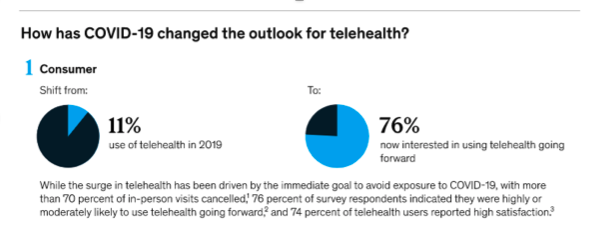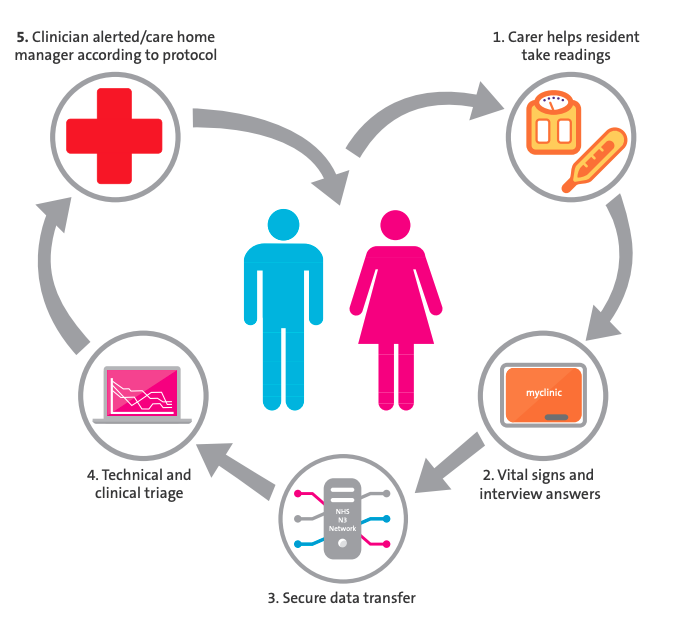TeleHealth Post COVID
What will healthcare for patients look like?
by WanavaKind
•
The healthcare sector is slow to adapt to digital transformation. Data privacy, cost, legacy technology, and the impact on workers have notoriously put up barriers for innovation. However, over the last decade, successful use cases are helping to gain consumer trust in transformative approaches. Telehealth is one of the technologies that are now firmly integrating itself within healthcare.
According to AAARP, 87% of adults aged 65 and older want to stay in their current home and community as they age. Telehealth programs allow them to do just that as healthcare providers can reach more patients remotely. The onset of the Covid-19 pandemic in 2020 has highlighted the potential benefits of telehealth solutions to other demographics, often to those previously reluctant to use the services.
In this post, we will look at what telehealth is, use cases during the Covid-19 pandemic, and the future of such technology within the healthcare sector.
Some of the most popular telehealth services include telemedicine, telehealth nursing, telemonitoring, physical therapy, and telepsychiatry. We look at some examples later in this article, but generally, telehealth services come in three forms.
- Synchronous telehealth services are what people generally associate with the technology. This includes the use of audio and visual interaction, using a smartphone, tablet, or computer.
- Asynchronous technology is where messages, images, or data are collected at a point in time and can be interpreted later. A patient portal will facilitate communication between them and the provider.
- Patient monitoring allows direct transmission of clinical measurements remotely to their healthcare provider
Before Covid-19, there have been some increases in the number of digital tools and that patients are using. New policies during Covid-19 reduce barriers to telehealth access and promote it as a way of delivering acute, chronic, primary, and secondary care.
During the pandemic, there is a considerable acceleration in the use of telehealth, with 76% of US consumers interested in telehealth services going forwards.

Source: McKinsey
Until a vaccine for Covid-19 becomes commercially available, it is unlikely these trends will change. Virtual and digital health have the opportunity to embed themselves as services within the industry, assuming challenges around security, integration, and effectiveness are overcome.
After an initial consult, patients only require further evaluation when absolutely necessary. Those who need care can get it from the comfort of their own home, reserving hospital capacity for high-risk patients. As well as that, patients with long term conditions like diabetes or hypertension can have routine visits virtually, rather than risking a trip to the hospital or clinic.
Alibaba launched a platform providing consultations for Chinese living overseas, linking then to volunteer doctors during the pandemic. Without such a service, they may not have received the necessary care in a timely manner.
Beyond Covid-19, the spike in usage of telemedicine will likely help it to gather momentum, even when the crisis is over. Coupled with the impending 5G technology, which improves connectivity, and more powerful mobile services, the consumer market is seeing substantial benefits in this form of telehealth service.
In a trial through Care UK, twelve dementia residents in a home have their vital signs recorded via a tablet. The information transfers to a triage team who can respond to any anomalies proactively. Patients benefit from ensuring that the team pick up any potential conditions, while the healthcare system lowers their admission costs.

Source: Tunstall
The result of telehealth services during the trial is improving the quality of life for dementia patients.
Consistent monitoring through telehealth gives providers a 24-hour profile and a better understanding of the patient's condition. As people accept the use of telehealth services post-Covid-19, there is an opportunity for improving the self-management of these lifelong conditions.
Tech-enabled home medication administration
Diabetes is an excellent example of the potential for home medication administration. Through remote monitoring, patients can better understand their need for fo infusible and injectable drugs. As long as there is an overseeing nurse, rather than visiting a clinic for medication, they can receive home deliveries, safe in the knowledge that their condition is being monitored adequately with telehealth services.
According to AAARP, 87% of adults aged 65 and older want to stay in their current home and community as they age. Telehealth programs allow them to do just that as healthcare providers can reach more patients remotely. The onset of the Covid-19 pandemic in 2020 has highlighted the potential benefits of telehealth solutions to other demographics, often to those previously reluctant to use the services.
In this post, we will look at what telehealth is, use cases during the Covid-19 pandemic, and the future of such technology within the healthcare sector.
What is telehealth?
Telehealth is the use of mobile technology, such as doctor visits and remote patient monitoring tools. The services aim to extend the reach of physicians and healthcare providers beyond their typical clinical foundation. Using telehealth services, there is a continuous stream of data and communication between patients and caregivers, allowing for a viable alternative to a traditional face-to-face health system.Some of the most popular telehealth services include telemedicine, telehealth nursing, telemonitoring, physical therapy, and telepsychiatry. We look at some examples later in this article, but generally, telehealth services come in three forms.
- Synchronous telehealth services are what people generally associate with the technology. This includes the use of audio and visual interaction, using a smartphone, tablet, or computer.
- Asynchronous technology is where messages, images, or data are collected at a point in time and can be interpreted later. A patient portal will facilitate communication between them and the provider.
- Patient monitoring allows direct transmission of clinical measurements remotely to their healthcare provider
Telehealth and Covid-19
Covid-19 emphasizes the need for changes to the existing healthcare system. The need to reduce staff exposure to those suffering from the illness, a requirement to preserve protective equipment, and reduce the spread through hospital footfall, are three core goals. Telehealth services help provide the necessary care while reducing the risk of transmission.Before Covid-19, there have been some increases in the number of digital tools and that patients are using. New policies during Covid-19 reduce barriers to telehealth access and promote it as a way of delivering acute, chronic, primary, and secondary care.
During the pandemic, there is a considerable acceleration in the use of telehealth, with 76% of US consumers interested in telehealth services going forwards.

Source: McKinsey
Until a vaccine for Covid-19 becomes commercially available, it is unlikely these trends will change. Virtual and digital health have the opportunity to embed themselves as services within the industry, assuming challenges around security, integration, and effectiveness are overcome.
Telemedicine
Healthcare providers in the US, such as Spectrum Health and McLeod Health, offer free telemedicine screenings for Covid-19 symptoms. Telemedicine refers to two-way communication between the patient and provider using electronic, audio, and visual means. While the technology is not new, it has always represented a small segment of care provision. A pre-Covid-19 survey suggests that only 10% of Americans have used telehealth, and 75% do not have access or awareness of it.After an initial consult, patients only require further evaluation when absolutely necessary. Those who need care can get it from the comfort of their own home, reserving hospital capacity for high-risk patients. As well as that, patients with long term conditions like diabetes or hypertension can have routine visits virtually, rather than risking a trip to the hospital or clinic.
Alibaba launched a platform providing consultations for Chinese living overseas, linking then to volunteer doctors during the pandemic. Without such a service, they may not have received the necessary care in a timely manner.
Beyond Covid-19, the spike in usage of telemedicine will likely help it to gather momentum, even when the crisis is over. Coupled with the impending 5G technology, which improves connectivity, and more powerful mobile services, the consumer market is seeing substantial benefits in this form of telehealth service.
Telehealth and dementia
A patient with dementia has unique needs when it comes to healthcare provision. A primary reason for those with dementia being admitted to the hospital is that they cannot communicate when they feel unwell. Conditions could be left undiscovered until a stage when it is too late to assist.In a trial through Care UK, twelve dementia residents in a home have their vital signs recorded via a tablet. The information transfers to a triage team who can respond to any anomalies proactively. Patients benefit from ensuring that the team pick up any potential conditions, while the healthcare system lowers their admission costs.

Source: Tunstall
The result of telehealth services during the trial is improving the quality of life for dementia patients.
Telehealth and diabetes
9.4% of the American population has diabetes, but many are not aware that telehealth services can help them to manage the condition. Telehealth monitoring (telemonitoring) allows those with diabetes to monitor crucial metrics like blood sugar levels. The data feeds into an app that they share with healthcare providers. At the same time, using the data, the patient is notified of how their condition is trending (too high/low), letting them take the appropriate medication on a more proactive basis.Consistent monitoring through telehealth gives providers a 24-hour profile and a better understanding of the patient's condition. As people accept the use of telehealth services post-Covid-19, there is an opportunity for improving the self-management of these lifelong conditions.
Tech-enabled home medication administration
Diabetes is an excellent example of the potential for home medication administration. Through remote monitoring, patients can better understand their need for fo infusible and injectable drugs. As long as there is an overseeing nurse, rather than visiting a clinic for medication, they can receive home deliveries, safe in the knowledge that their condition is being monitored adequately with telehealth services.